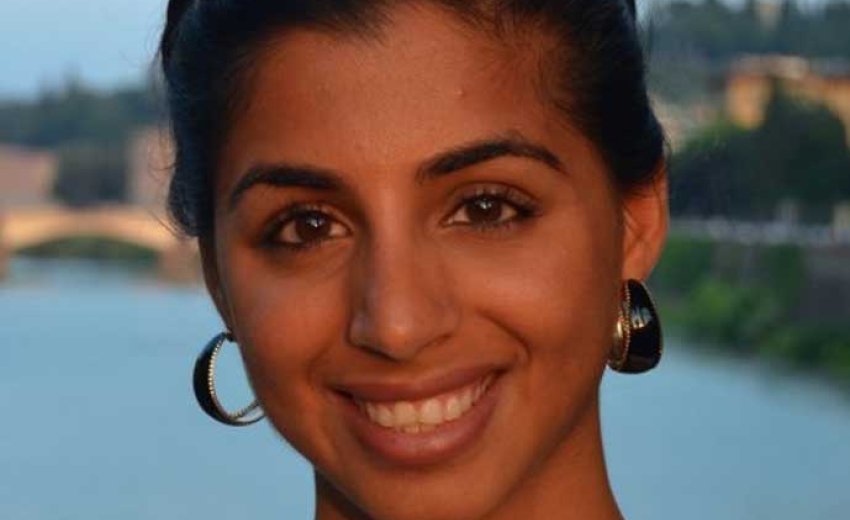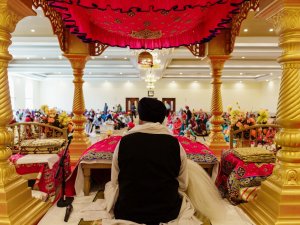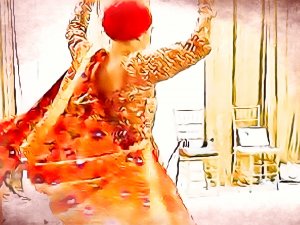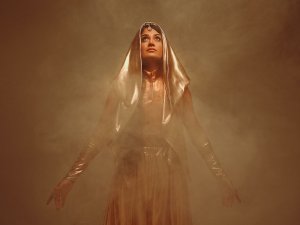
You
might own her artwork and not even know it.
You might have seen
her artwork at conferences, and not even realized it.
You might
have viewed her artwork online, and not known who it was by.
The artist you’ve been admiring is, Rupy Kaur.
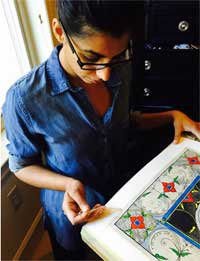 Rupy
Kaur is a self-taught artist, and her artwork has graced the cover of“Her name is Kaur,” been an emblem of Sikh Love Stories, and
branded SAFAR conference materials. She has also done design work
for several Sikh youth conferences for the last five years. Her
artwork is detailed, ethnic, bright and colorful: a tribute to her
Punjabi roots and heritage.
Rupy
Kaur is a self-taught artist, and her artwork has graced the cover of“Her name is Kaur,” been an emblem of Sikh Love Stories, and
branded SAFAR conference materials. She has also done design work
for several Sikh youth conferences for the last five years. Her
artwork is detailed, ethnic, bright and colorful: a tribute to her
Punjabi roots and heritage.
“Having a multicultural upbringing [Punjabi and American] I focus on things or objects that identify us as people,” Rupy explained. She referenced a phulkair chuni as an example. “I analyze the significance it carries for me as a Punjabi and as an American. Is there duality or a clash? How does it define me?” Further drawing on her culture, Rupy draws inspiration from Indian and Persian miniatures. “I gravitate towards the colorful, decorative nature of traditional art along with the devotion and time that goes into creating it.” But every day is different for Rupy. “It’s healthy to engage with different styles. It’s fun, fresh, and engaging.”
Rupy has been creating art ever since she was young. “In elementary school, art was a part of the daily curriculum. I thought of it as an ‘easy’ class but ironically I would work the hardest in that class all the way through high school. My art teachers said I would be great but they never pushed me to think of it as a career.” But after high school, Rupy’s career path deviated from art.
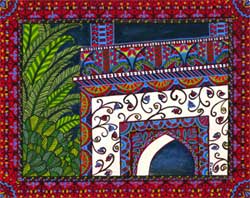 “I
went the more ‘traditional’ route and got a Master’s in Public
Health after studying biology in undergrad. I found it to be an
easier path to follow; it’s what I was exposed to growing up.”
Rupy went on to work for a non-profit for three years and served as a
global health instructor as well. Though she enjoyed it, she felt
like she was not meeting her potential. After moving to the Bay Area,
Rupy decided she would try making art a full time endeavor.
“Fortunately it worked out! I’ve been a professional artist for
four years now!”
“I
went the more ‘traditional’ route and got a Master’s in Public
Health after studying biology in undergrad. I found it to be an
easier path to follow; it’s what I was exposed to growing up.”
Rupy went on to work for a non-profit for three years and served as a
global health instructor as well. Though she enjoyed it, she felt
like she was not meeting her potential. After moving to the Bay Area,
Rupy decided she would try making art a full time endeavor.
“Fortunately it worked out! I’ve been a professional artist for
four years now!”
“Being a full time artist has been the scariest thing ever, and the most rewarding thing too!” Rupy said she had to undo everything she knew about herself and what she wanted her life to look like when she stepped onto the art path. She developed patience, self-discipline, and self-confidence for a career that was completely unfamiliar to her.
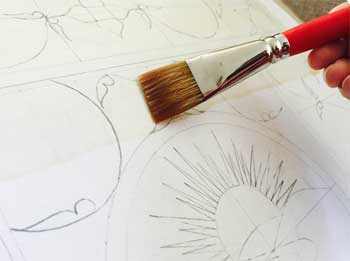 Rupy
had her first public showing as a professional artist at the Sikhlens
Film Festival in 2011. “The festival audience was very
encouraging and all of my paintings were appreciated and purchased,”
she said. Rupy continues to show at Sikh events and values the
feedback from her Sikh community, as it is a group very dear and
close to her. She also shows in retail shows and group shows with
other artists.
Rupy
had her first public showing as a professional artist at the Sikhlens
Film Festival in 2011. “The festival audience was very
encouraging and all of my paintings were appreciated and purchased,”
she said. Rupy continues to show at Sikh events and values the
feedback from her Sikh community, as it is a group very dear and
close to her. She also shows in retail shows and group shows with
other artists.
Creating art brings with it an element of constant self-reflection for Rupy. “My work is a reflection of who I am,” said. Questions such as: “What can I do differently? What can I do better? What do I want to communicate? What do I want the audience to comment on or notice?” fill Rupy’s mind on a daily basis. “I embody the answers to these questions in a piece of work for the world to see. I would have never thought that I would have the confidence or self assurance to say ‘This is what I disagree with’ or ‘This is who I want to be,’ through my paintings.”
In addition to her family and loved ones, Rupy feels that her Sikhi is instrumental in keeping her afloat as an artist. “To say that Sikhi inspires my art is an understatement. So much of Sikhi is already embodied in who I am; it is not separate, it is a part of who I am so, my work reflects it automatically. When I have self-doubt, I always resort to a bigger power than myself, Waheguru. Nitnem keeps me going too, it’s my medicine for tough times.”
Sikhi provides the guidelines and values by which Rupy lives, creates, and works. One line in gurbani particularly resonates with her.

Farīḏā
kẖālak kẖalak mėh kẖalak vasai rab māhi.
Fareed, the
Creator is in the Creation, and the Creation abides in God.
Guru
Arjan Sahib, Panna 1381, Line 17
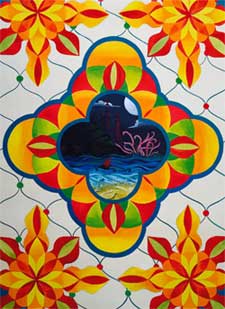 “This
is applicable to me in the way I create my work,” said Rupy. “I
don’t think I’m creating it but I feel like something flows
through me; it comes from the divine. I am a part of creation so I
can’t call myself a creator. I am one who precepts. For me, art is
essentially a form of prayer to the Creator who has given me my
abilities.”
“This
is applicable to me in the way I create my work,” said Rupy. “I
don’t think I’m creating it but I feel like something flows
through me; it comes from the divine. I am a part of creation so I
can’t call myself a creator. I am one who precepts. For me, art is
essentially a form of prayer to the Creator who has given me my
abilities.”
Finding self-worth and value in life beyond money is something that Sikhi teaches and Rupy finds that it is a lesson re-enforced through art. “It’s a struggle to think of art as a business while making art that is true to myself as an artist. As a result, I have had to define success for myself beyond commissions and sales.” For Rupy, success is when she produces what she wants to produce. “To have my work in places where people look at it and are affected by it, that is success for me. Success is if they feel happy or remember something beautiful in life, or a memory is rekindled. I want my audience to be able to connect with me through my work.”
In the future, Rupy hopes to explore, through art, the identity of people as reflected by the objects that define each person physically. In addition, Rupy wants to depict the identity of women and the roles that define a contemporary Punjabi woman. “I decided a long time ago that I want to dissect the identity of who a woman is and work on my own career being a woman through the process. I don’t want to forget how important we are and what impact we can have in the world.”
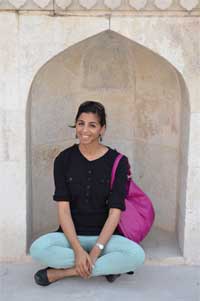 Rupy’s
future repertoire is full of interesting topics: Skin color, race &
the media, duality in identity, and gurbani. But ultimately, Rupy
wants to continue to be excited to create and work on different types
of art everyday. “I get bored easily and as an artist, it’s very
important to find meaning and value in what I do.” She also hopes
to reach out to other Sikh artists for collaboration pieces.
Rupy’s
future repertoire is full of interesting topics: Skin color, race &
the media, duality in identity, and gurbani. But ultimately, Rupy
wants to continue to be excited to create and work on different types
of art everyday. “I get bored easily and as an artist, it’s very
important to find meaning and value in what I do.” She also hopes
to reach out to other Sikh artists for collaboration pieces.
Rupy feels that the Punjabi community doesn’t support people to pursue art and she sees so much lost potential. “I want to break down the fear around art as a career.” So, if there’s one thing Rupy wants to be known for, it is encouraging everyone to create art and value the creative process and space. “It’s not hard to be creative. It is not something that only ‘gifted’ people should do. Being creative is in our nature. If you enjoy it and want to work very very very hard, then pursue it! Make it a career.”
Check out Rupy’s Art:
www.instagram.com/artbyrupy
https://www.facebook.com/RupyCheemaTut
http://www.artbyrupy.com/
